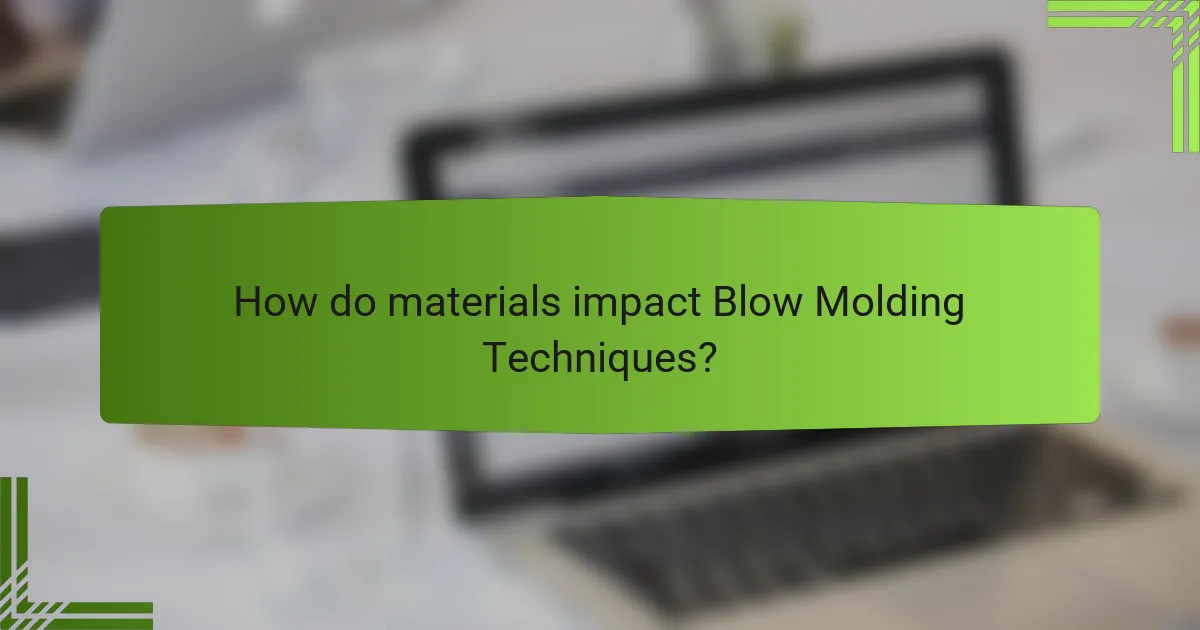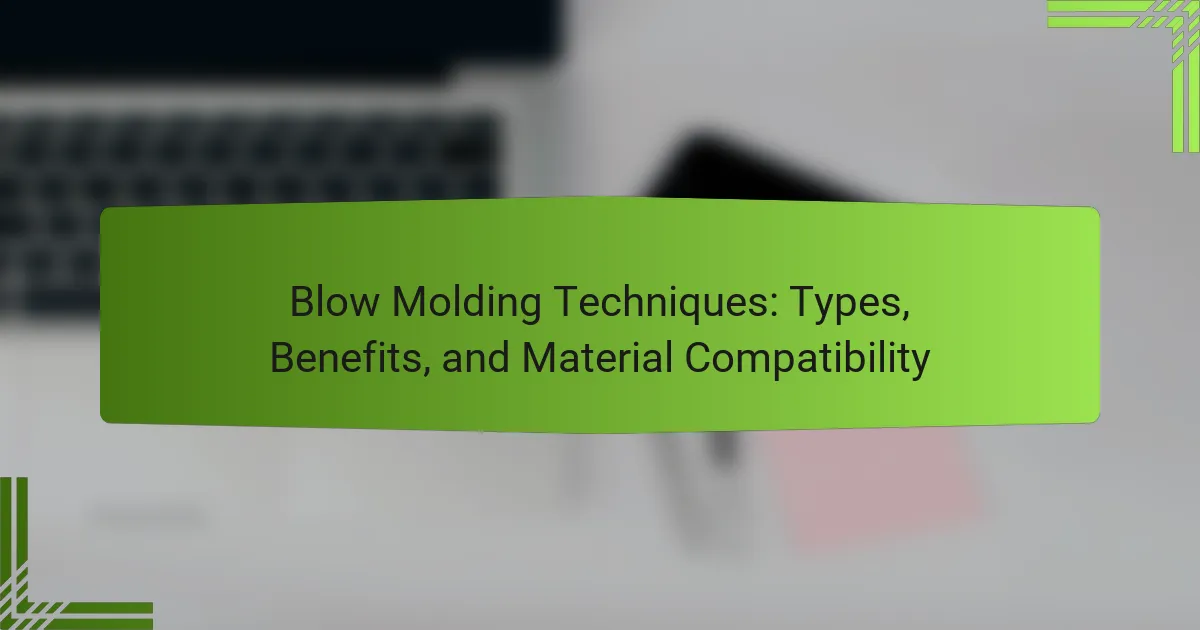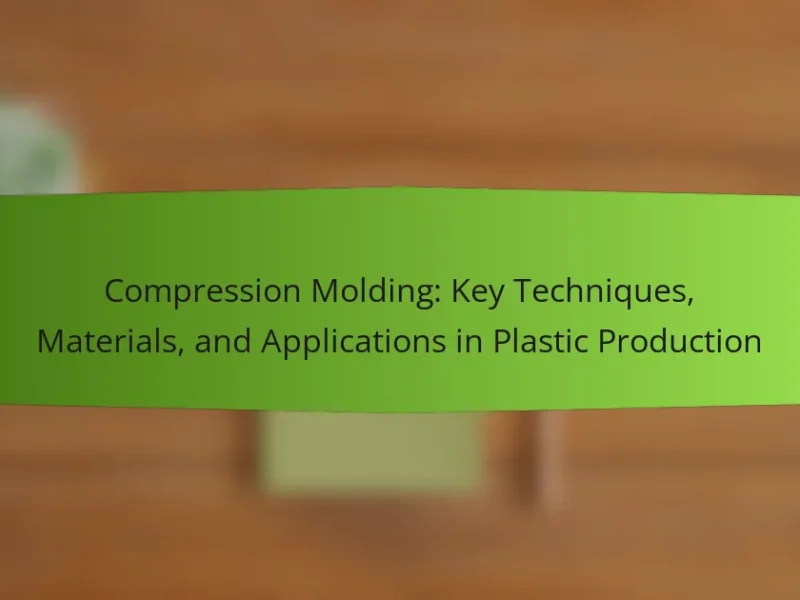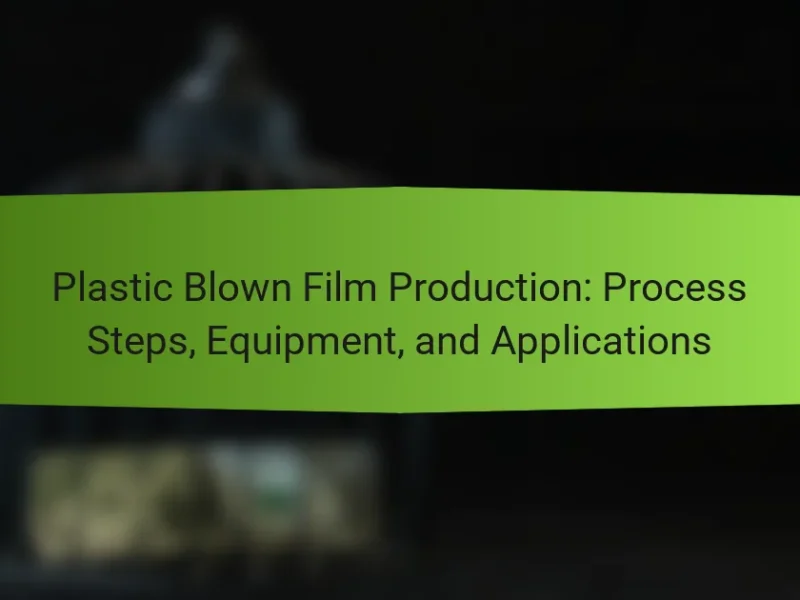Blow molding techniques are manufacturing processes employed to produce hollow plastic parts through the inflation of heated plastic tubes into molds. The primary types of blow molding include extrusion blow molding, injection blow molding, and stretch blow molding, each serving distinct design requirements and material types. Material selection significantly influences processing conditions, product characteristics, and design possibilities, with common materials like polyethylene, polypropylene, and PET exhibiting unique thermal and mechanical properties. Effective blow molding requires precise temperature control, high-quality materials, regular equipment maintenance, and skilled operator training, all of which contribute to enhanced production efficiency and product quality.

What are Blow Molding Techniques?
Blow molding techniques are manufacturing processes used to create hollow plastic parts. These techniques involve inflating a heated plastic tube into a mold. The key types include extrusion blow molding, injection blow molding, and stretch blow molding. Extrusion blow molding creates parts by extruding plastic into a tube. Injection blow molding combines injection molding and blow molding for precise shapes. Stretch blow molding is used for producing strong, lightweight containers. Each technique caters to different design requirements and material types. For instance, PET is commonly used in stretch blow molding for bottles.
How do Blow Molding Techniques work?
Blow molding techniques work by inflating a heated plastic tube into a mold. The process begins with thermoplastic material being heated until it becomes pliable. This material is then extruded into a hollow tube called a parison. Air is injected into the parison, causing it to expand and take the shape of the mold. The mold is then cooled, solidifying the plastic into the desired shape. This method is commonly used for producing hollow objects such as bottles and containers. The efficiency of blow molding allows for high production rates and uniformity in product design.
What are the essential components of Blow Molding Techniques?
The essential components of blow molding techniques include the mold, material, and blowing mechanism. The mold shapes the final product and is typically made from metal. The material used is often thermoplastic, such as polyethylene or polypropylene. The blowing mechanism introduces air into the heated material, expanding it to fit the mold. Heating equipment prepares the material for molding by softening it. Cooling systems solidify the molded product after shaping. Each component plays a critical role in the efficiency and quality of the blow molding process.
How do the components interact during the blow molding process?
During the blow molding process, components such as the parison, mold, and air supply interact in a specific sequence. The parison is extruded and placed into the mold. The mold closes around the parison, creating a cavity. Compressed air is then introduced into the parison. This air expands the parison to fill the mold’s shape. The interaction between the air pressure and the parison material determines the final product’s thickness and surface quality. Cooling occurs as the material solidifies against the mold walls. This process ensures the product maintains its form and structural integrity. Each component’s precise timing and coordination are critical for successful blow molding.
What types of Blow Molding Techniques exist?
There are three main types of blow molding techniques: extrusion blow molding, injection blow molding, and stretch blow molding. Extrusion blow molding involves extruding a plastic tube and then inflating it within a mold. This method is commonly used for producing hollow objects like bottles and containers. Injection blow molding combines injection molding and blow molding. It starts with a preform that is molded and then blown into shape. This technique is often used for high-precision applications. Stretch blow molding involves stretching the preform before blowing it into the final shape. This results in stronger and clearer products. Each technique has specific applications and benefits, making them suitable for different manufacturing needs.
What is Extrusion Blow Molding?
Extrusion blow molding is a manufacturing process used to create hollow plastic parts. It involves extruding a heated thermoplastic tube, known as a parison. The parison is then inflated within a mold to form the desired shape. This technique is commonly used for producing bottles, containers, and other hollow products. Extrusion blow molding allows for high production rates and is suitable for various thermoplastics. The process can accommodate complex designs and offers good material efficiency. It is widely utilized in industries such as packaging and automotive.
How does Injection Blow Molding differ from other techniques?
Injection Blow Molding (IBM) differs from other techniques by combining injection molding and blow molding processes. IBM begins with the injection of molten plastic into a mold to form a preform. This preform is then heated and inflated using air to create the final shape. Unlike extrusion blow molding, which uses a continuous process to form containers, IBM allows for more complex shapes and precise dimensions. Additionally, IBM typically produces thinner walls and better surface finishes compared to other blow molding techniques. This method is ideal for small to medium-sized containers, particularly for applications requiring high precision. The ability to use various thermoplastics further enhances its versatility in manufacturing.
What is the process of Stretch Blow Molding?
Stretch Blow Molding is a manufacturing process used to create plastic containers. It involves heating a preform and then stretching it while blowing air into it. The preform is typically made from PET or similar thermoplastics.
First, the preform is heated until it becomes soft. Next, it is placed in a mold. The mold shapes the preform into the desired container form. Air is then injected, stretching the preform and expanding it to fit the mold.
This process enhances the strength and clarity of the final product. Stretch Blow Molding is commonly used for producing bottles and other hollow plastic items. It is efficient for high-volume production.
What benefits do Blow Molding Techniques offer?
Blow molding techniques offer several benefits in manufacturing. They allow for the production of lightweight, hollow plastic parts. This process is efficient and can produce complex shapes. Blow molding also enables high production rates, reducing manufacturing costs. The technique allows for the use of various thermoplastics, enhancing material compatibility. Additionally, it supports recycling initiatives by using recycled materials. The final products often exhibit excellent strength-to-weight ratios. These advantages make blow molding a preferred choice in industries like packaging and automotive.
How do Blow Molding Techniques improve production efficiency?
Blow molding techniques improve production efficiency by enabling high-speed manufacturing of plastic parts. These methods allow for rapid production cycles, resulting in shorter lead times. The process reduces material waste due to precise control over wall thickness. Additionally, blow molding can produce complex shapes in a single step, minimizing assembly time. Multi-cavity molds increase output, allowing for multiple parts to be produced simultaneously. Automation in blow molding further enhances efficiency by reducing labor costs and human error. According to industry studies, blow molding can achieve production rates of up to 1,000 parts per hour, demonstrating significant efficiency advantages.
What cost advantages do Blow Molding Techniques provide?
Blow molding techniques provide significant cost advantages in manufacturing plastic products. These methods allow for high production speeds, reducing labor costs per unit. The efficiency of blow molding results in less material waste compared to other methods. This process also enables the creation of complex shapes without the need for extensive tooling. Additionally, blow molding can produce lightweight products, which reduces shipping costs. The scalability of blow molding allows manufacturers to increase production without a proportional increase in costs. Overall, these factors contribute to lower overall production costs in the plastic manufacturing industry.
How does blow molding enhance product design flexibility?
Blow molding enhances product design flexibility by allowing for the creation of complex shapes and sizes. This technique can produce hollow parts with varying wall thicknesses. It accommodates different materials, providing options for functionality and aesthetics. Designers can easily modify existing molds to create new products. The process supports rapid prototyping, enabling quick iterations. Additionally, blow molding reduces material waste, making it cost-effective. This flexibility is crucial for industries needing customized solutions. Overall, blow molding significantly expands design possibilities for manufacturers.

How do materials impact Blow Molding Techniques?
Materials significantly impact blow molding techniques by determining the processing conditions and product characteristics. Different materials, such as polyethylene, polypropylene, and PET, have unique thermal and mechanical properties. For example, polyethylene has a lower melting point, allowing for faster processing. Conversely, PET requires higher temperatures, influencing cycle times and energy consumption.
Additionally, the viscosity of the material affects the ease of shaping and the quality of the final product. High-viscosity materials may lead to uneven wall thicknesses, while low-viscosity materials can create smoother finishes. The choice of material also impacts the design possibilities, as some materials can be molded into intricate shapes while others are more limited.
Moreover, the compatibility of materials with additives or colorants can alter the blow molding process. Certain additives may enhance properties like UV resistance or flexibility, while others may require adjustments in processing parameters. Overall, the selection of material directly influences the efficiency, quality, and versatility of blow molding techniques.
What materials are commonly used in Blow Molding?
Common materials used in blow molding include polyethylene, polypropylene, and polyvinyl chloride. Polyethylene is widely utilized due to its excellent flexibility and chemical resistance. Polypropylene offers a higher melting point and is known for its strength and durability. Polyvinyl chloride is favored for its rigidity and versatility in various applications. Other materials like PET (polyethylene terephthalate) are also employed, especially for producing bottles and containers. These materials are chosen for their specific properties that meet the requirements of blow molding processes.
How does material selection affect the blow molding process?
Material selection significantly influences the blow molding process. Different materials exhibit varying properties that affect processing conditions. For instance, thermoplastics like polyethylene and polypropylene are commonly used due to their ease of molding and good flow characteristics. These materials can be heated and cooled repeatedly without losing their properties.
In contrast, materials like PVC may require specific temperature controls to avoid degradation. The viscosity of the selected material impacts the speed and efficiency of the molding process. Higher viscosity materials may require increased pressure and temperature, affecting cycle times.
Additionally, the chosen material determines the final product’s mechanical properties, such as strength and flexibility. For example, using PET can yield stronger and more rigid products compared to using lower-grade plastics. The compatibility of the material with the blow molding machine is also crucial. Mismatched materials can lead to defects or failures during production.
Overall, careful material selection ensures optimal processing conditions, product quality, and manufacturing efficiency in blow molding.
What are the properties of polyethylene in blow molding?
Polyethylene has several key properties that make it suitable for blow molding. It is lightweight, which reduces transportation costs. Polyethylene exhibits excellent chemical resistance, making it ideal for packaging applications. The material has good impact strength, ensuring durability in various environments. Polyethylene also has a low melting point, facilitating easy processing during blow molding. Its flexibility allows for the creation of complex shapes and designs. Additionally, polyethylene can be produced in different densities, such as low-density polyethylene (LDPE) and high-density polyethylene (HDPE), catering to diverse applications. These properties collectively enhance the efficiency and effectiveness of blow molding processes.
What are the compatibility considerations for materials in Blow Molding?
Compatibility considerations for materials in blow molding include thermal properties, chemical resistance, and mechanical strength. Materials must withstand the heating and cooling processes involved in blow molding. The thermal expansion of different materials can affect the final product’s integrity. Chemical compatibility is crucial to prevent reactions that can weaken the material. Mechanical strength ensures the molded product can withstand handling and usage. Additionally, the materials should have similar processing temperatures to ensure a uniform flow during molding. This compatibility directly influences the quality and performance of the final blow-molded product.
How do different materials influence the final product quality?
Different materials significantly influence the final product quality in blow molding. The choice of material affects strength, flexibility, and durability. For instance, polyethylene offers good impact resistance and is lightweight. In contrast, polypropylene provides higher temperature resistance and better chemical stability.
Materials also impact surface finish and clarity. Clear materials like PET enhance aesthetic appeal. Additionally, the material’s melt flow index affects the molding process and final product consistency.
Research indicates that the right material selection can reduce production costs and improve product lifespan. For example, a study published in the Journal of Applied Polymer Science found that using high-density polyethylene resulted in a 20% increase in tensile strength compared to low-density polyethylene.
What challenges arise when using multiple materials in blow molding?
Challenges in using multiple materials in blow molding include compatibility issues, processing difficulties, and cost implications. Different materials may have varying melting points, which complicates the molding process. This can lead to poor adhesion between layers, affecting the structural integrity of the final product. Additionally, the differing shrinkage rates of materials can cause warping or distortion. The need for specialized equipment to handle multiple materials increases production costs. Furthermore, recycling and waste management become more complex when combining materials. These challenges necessitate careful material selection and process optimization to ensure quality outcomes.

What are best practices for successful Blow Molding?
To achieve successful blow molding, it is essential to maintain precise temperature control throughout the process. Proper temperature management ensures optimal material flow and reduces defects. Additionally, using high-quality materials is crucial. Quality materials enhance the final product’s strength and durability.
Regular maintenance of blow molding equipment is another best practice. Well-maintained machinery minimizes downtime and improves production efficiency. Implementing thorough quality control measures during production is also important. This step ensures that any defects are identified and addressed promptly.
Training operators on best practices and safety protocols enhances overall production quality. Skilled operators can better manage the complexities of the blow molding process. Lastly, optimizing cycle times can significantly improve productivity. Efficient cycle times lead to increased output without compromising product quality.
How can manufacturers optimize their Blow Molding processes?
Manufacturers can optimize their Blow Molding processes by improving machine settings, material selection, and mold design. Adjusting parameters such as temperature, pressure, and cycle time enhances product quality. Selecting high-quality materials reduces defects and increases durability. Implementing advanced mold designs minimizes material waste and allows for complex shapes. Regular maintenance of equipment ensures consistent performance and longevity. Utilizing simulation software can predict outcomes and optimize designs before production. Training staff on best practices promotes efficiency and reduces errors. These strategies collectively enhance productivity and product quality in Blow Molding processes.
What maintenance tips ensure longevity of blow molding equipment?
Regular maintenance of blow molding equipment is essential for its longevity. Conduct routine inspections to identify wear and tear. Lubricate moving parts as per the manufacturer’s guidelines. Clean the machine components to prevent buildup of debris. Monitor temperature settings to avoid overheating. Replace worn-out parts promptly to maintain efficiency. Ensure proper calibration of sensors and controls for optimal performance. Follow the manufacturer’s maintenance schedule for preventive care. These practices can significantly extend the lifespan of blow molding equipment.
How can troubleshooting common issues improve production outcomes?
Troubleshooting common issues enhances production outcomes by identifying and resolving problems efficiently. Effective troubleshooting minimizes downtime and reduces waste during the production process. For example, addressing equipment malfunctions quickly can lead to a 20% increase in production efficiency. Analyzing defects in blow molding can improve product quality, leading to fewer returns. Implementing corrective actions based on troubleshooting can also lower operational costs. Data from manufacturing studies shows that proactive issue resolution can increase overall productivity by up to 30%. Therefore, systematic troubleshooting is vital for optimizing production outcomes in blow molding techniques.
Blow molding techniques are manufacturing processes used to create hollow plastic parts through methods such as extrusion blow molding, injection blow molding, and stretch blow molding. These techniques involve inflating heated thermoplastic materials into molds, resulting in efficient production of various shapes and sizes. The article covers the working principles, essential components, and benefits of blow molding, along with the impact of material selection on product quality and design flexibility. It also discusses best practices for optimizing blow molding processes and troubleshooting common issues to enhance production outcomes.


